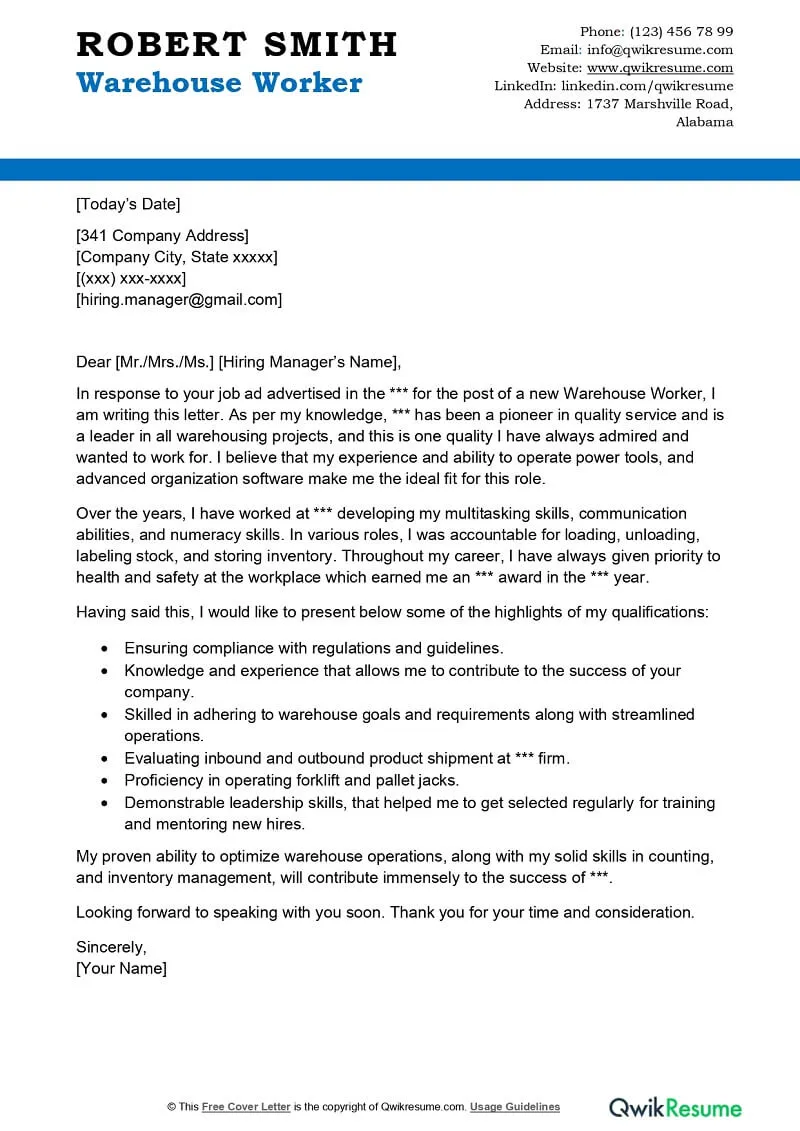Why a Warehouse Cover Letter Is Essential
In the competitive world of warehouse jobs, a well-crafted cover letter can be the deciding factor between getting an interview and being overlooked. A warehouse cover letter is not just a formality; it’s your chance to make a strong first impression and showcase why you’re the perfect fit for the role. It allows you to go beyond your resume, providing context and highlighting specific skills and experiences that directly align with the job requirements. A compelling cover letter demonstrates your genuine interest in the position and the company, setting you apart from other applicants and increasing your chances of landing an interview. It’s your personal introduction to the hiring manager, giving you an opportunity to showcase your personality and enthusiasm.
Understanding the Warehouse Role
Before you start writing, it’s crucial to understand the typical roles and responsibilities within a warehouse environment. Warehouses are the backbone of supply chains, and the jobs within them vary significantly. From receiving and storing goods to picking, packing, and shipping orders, warehouse employees play a vital role in ensuring products reach their destination efficiently and effectively. Knowing the different types of warehouse roles will help you tailor your cover letter to the specific position you’re applying for, making your application more targeted and impactful. This understanding will also enable you to use the correct keywords and demonstrate your knowledge of the industry.
Key Responsibilities in a Warehouse

Warehouse responsibilities can include a variety of tasks, depending on the specific role. These might encompass receiving and unloading shipments, verifying the accuracy of incoming and outgoing orders, stocking shelves, and maintaining inventory records. Warehouse staff also use equipment like forklifts, pallet jacks, and conveyor systems, so experience with these tools is often a key requirement. Adhering to safety protocols is another paramount responsibility, as warehouses can be hazardous environments. Attention to detail, physical stamina, and the ability to work efficiently under pressure are also highly valued in warehouse positions. Describing these responsibilities in your cover letter shows the hiring manager you understand the demands of the role.
Essential Skills for Warehouse Positions
Certain skills are consistently sought after in warehouse employees. These include the ability to work as part of a team, strong organizational skills, and proficiency in using warehouse management systems (WMS). Experience with inventory control and order fulfillment is also highly desirable. Many warehouse jobs require physical stamina and the ability to lift heavy objects, so highlighting your physical capabilities is crucial. Strong communication skills are also necessary for coordinating with colleagues and supervisors. Mentioning these essential skills in your cover letter, along with examples of how you’ve used them in the past, will make your application stand out.
Crafting a Compelling Cover Letter
A well-written cover letter can significantly increase your chances of getting an interview. It should be clear, concise, and tailored to the specific job you’re applying for. Avoid generic templates and instead focus on highlighting your relevant skills and experience. Personalize your letter by mentioning the company’s name and the specific position you’re interested in. Show your enthusiasm for the opportunity and explain why you’re a good fit for the role. Proofread your letter carefully to catch any errors in grammar or spelling, as these can create a negative impression. A compelling cover letter is your chance to shine, so make it count.
Header and Contact Information
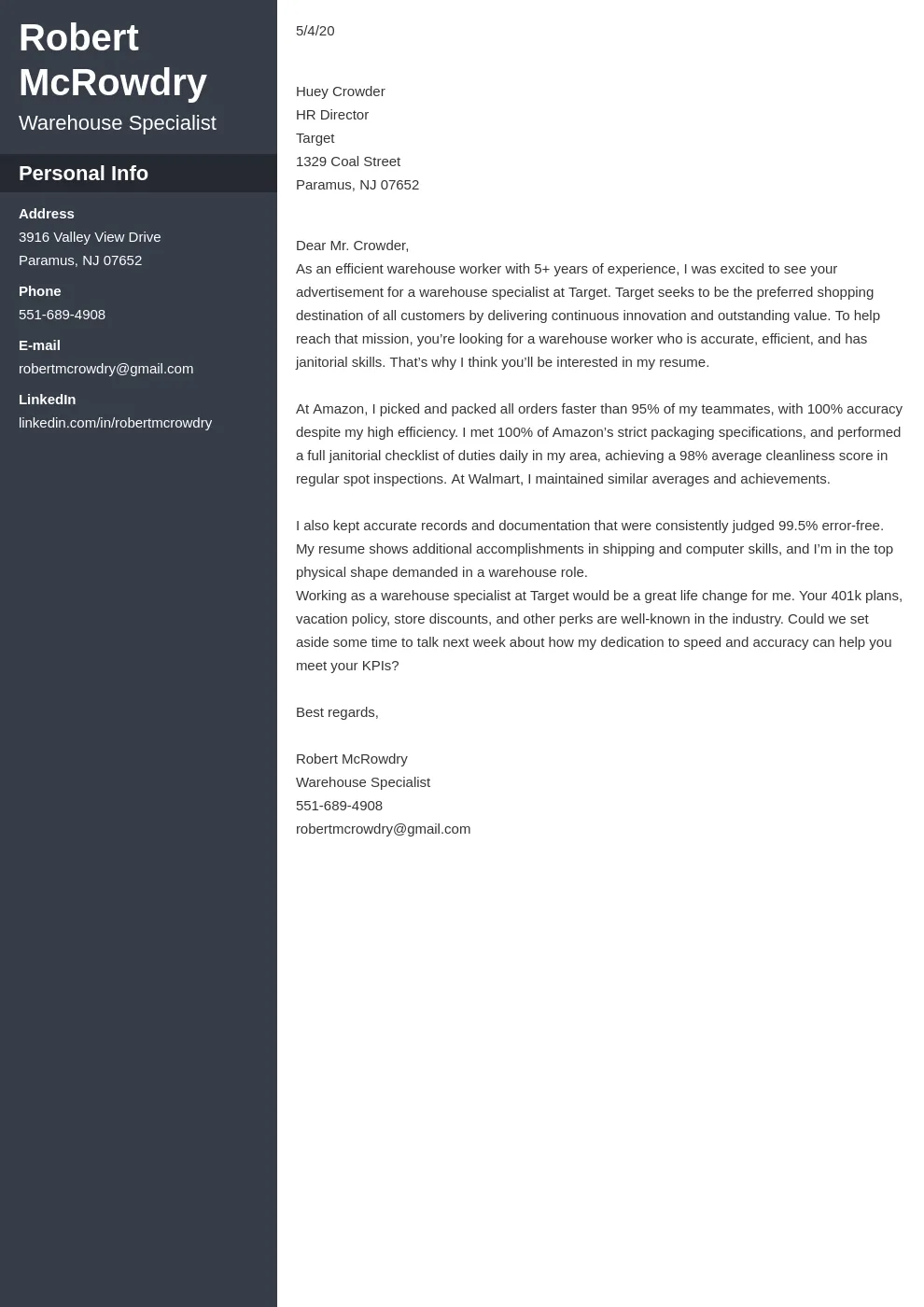
Start your cover letter with a professional header that includes your contact information. This should include your full name, address, phone number, and email address. Also, include the date and the hiring manager’s name and title, if you know it. If you’re unsure of the hiring manager’s name, research the company or use a general salutation like “Dear Hiring Manager.” Ensuring your contact information is accurate and easily accessible is essential, as this is how the employer will reach you if they want to schedule an interview. Proper formatting and attention to detail in this section set the tone for the rest of your letter.
The Opening Paragraph – Grab Attention
The opening paragraph is your first opportunity to grab the hiring manager’s attention. Start with a strong statement that highlights your interest in the position and the company. Briefly mention your relevant skills or experience, and why you’re excited about the opportunity. Avoid generic phrases like “I am writing to express my interest.” Instead, state your interest directly and concisely. For example, you could say “I am writing to express my keen interest in the Warehouse Associate position at XYZ Company, as advertised on [Platform].” Show your understanding of the company’s needs and express your enthusiasm for the role.
Highlighting Relevant Experience and Skills
The body of your cover letter should focus on showcasing your relevant experience and skills. Review the job description carefully and identify the key requirements. Then, provide specific examples from your past experiences that demonstrate your ability to meet those requirements. Use action verbs to describe your accomplishments and quantify your achievements whenever possible. For instance, instead of saying “I managed inventory,” you could say “Managed inventory, resulting in a 15% reduction in discrepancies.” Tailor your letter to each job by highlighting the skills and experiences most relevant to that specific role.
Quantifying Achievements and Results
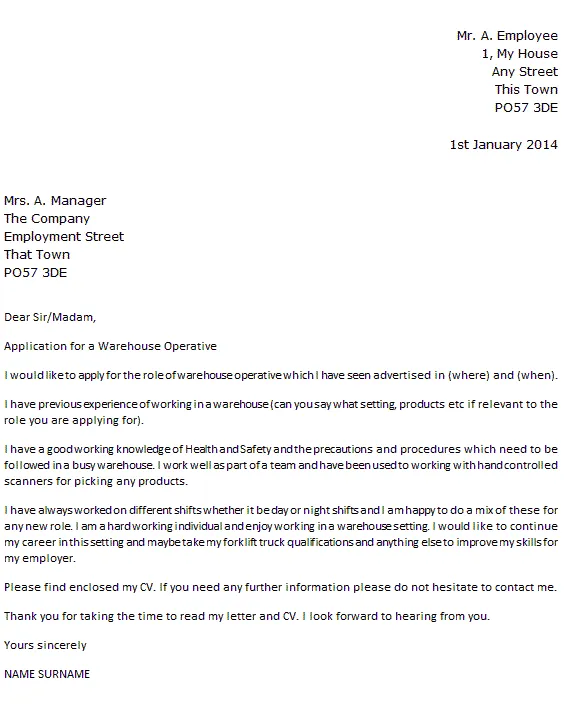
Whenever possible, quantify your achievements to demonstrate the impact you’ve made in previous roles. Use numbers and data to illustrate your accomplishments. For example, instead of saying “I improved order processing,” you could say “Improved order processing efficiency by 20%, resulting in a reduction in delivery times.” This provides concrete evidence of your skills and makes your achievements more compelling. Use metrics like percentages, numbers, or specific examples to highlight your impact on previous employers. This makes your accomplishments more tangible and easier for the hiring manager to understand.
Tailoring the Letter to the Job Description
One of the most important steps in writing a cover letter is tailoring it to the specific job description. Read the job posting carefully and identify the key requirements, skills, and qualifications the employer is seeking. Then, use your cover letter to address these requirements directly. Highlight your relevant skills and experience, and provide specific examples of how you’ve met similar challenges in the past. Demonstrate that you understand the needs of the role and that you have the skills and experience necessary to be successful. Tailoring your letter to each job shows the hiring manager that you’ve taken the time to understand the position and that you’re genuinely interested in the opportunity.
Expressing Enthusiasm and Interest
Throughout your cover letter, express your enthusiasm and interest in the position and the company. Show that you’ve researched the company and understand its mission and values. Mention something specific that attracts you to the role or the company. Your enthusiasm should be evident in your tone and language. Avoid sounding generic or formulaic; instead, let your personality shine through. A genuine expression of interest will make your cover letter more engaging and increase your chances of making a positive impression. Show your excitement for the opportunity to contribute to the company’s success.
The Closing Paragraph – Call to Action
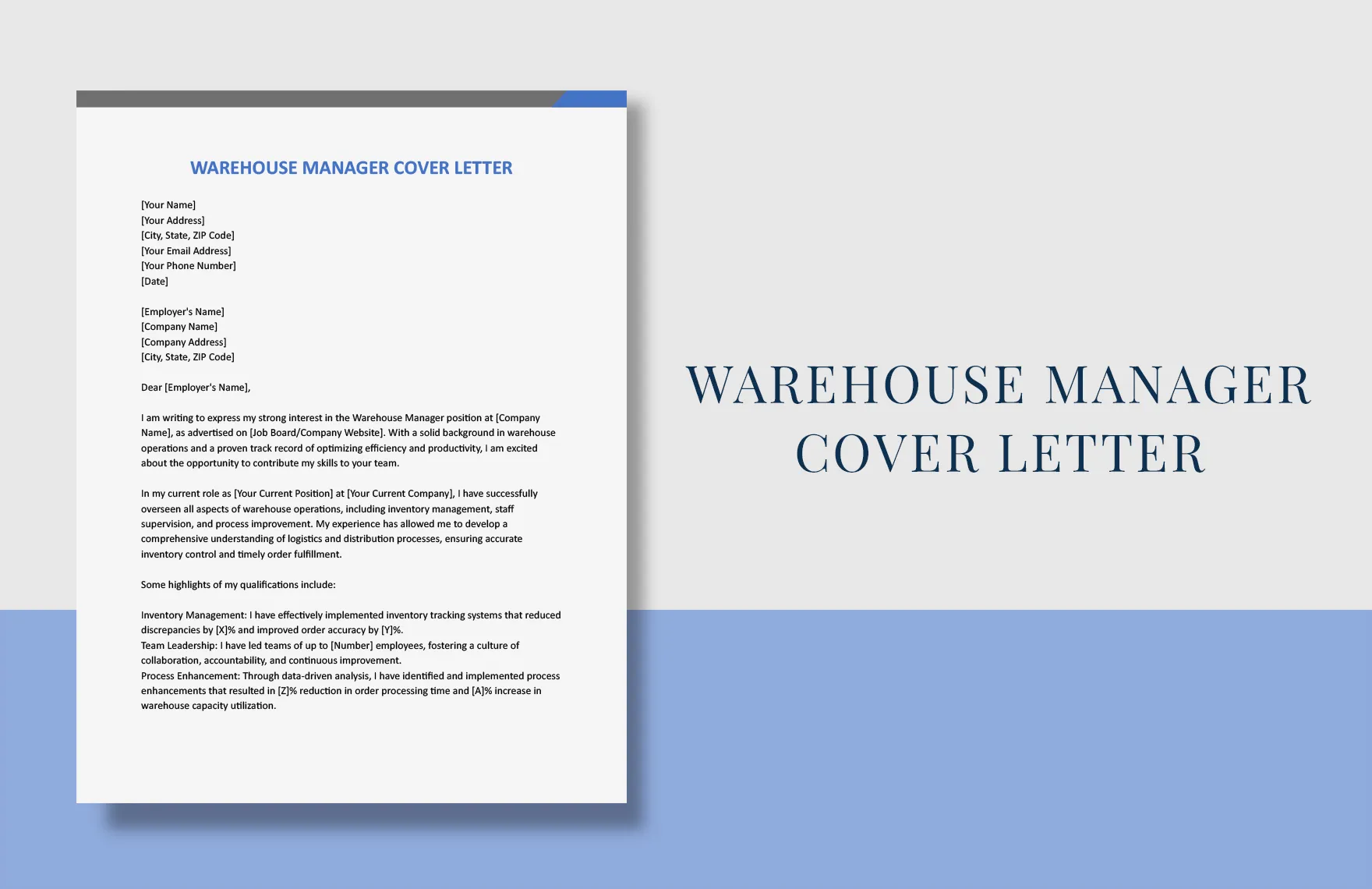
The closing paragraph should reiterate your interest in the position and express your availability for an interview. Thank the hiring manager for their time and consideration. Use a professional closing, such as “Sincerely,” or “Best regards,” followed by your name. If you’re comfortable, you can also provide a brief call to action, such as “I am eager to discuss my qualifications further in an interview.” Ensure that your contact information is readily available, making it easy for the hiring manager to reach you. Make it clear that you are looking forward to hearing from them soon.
Formatting and Proofreading
Proper formatting and proofreading are crucial for creating a professional cover letter. Your cover letter should be easy to read and visually appealing. Errors in grammar or spelling can create a negative impression, so take the time to review your letter carefully. Using a clean and consistent font, clear formatting, and ensuring there are no typos will show you are detail-oriented and care about the quality of your work. Proper formatting and careful proofreading are essential for making a positive impression on the hiring manager.
Formatting Guidelines for Cover Letters
Follow standard formatting guidelines to ensure your cover letter is easy to read. Use a professional font like Arial, Times New Roman, or Calibri. Maintain a consistent font size (typically 10-12 points). Use single spacing within paragraphs and double spacing between paragraphs. Keep your letter concise, ideally within one page. Use left alignment and avoid excessive use of bolding or italics. Ensure that your letter is well-organized and visually appealing. Pay attention to margins, and maintain a professional appearance throughout your letter.
Proofreading for Errors
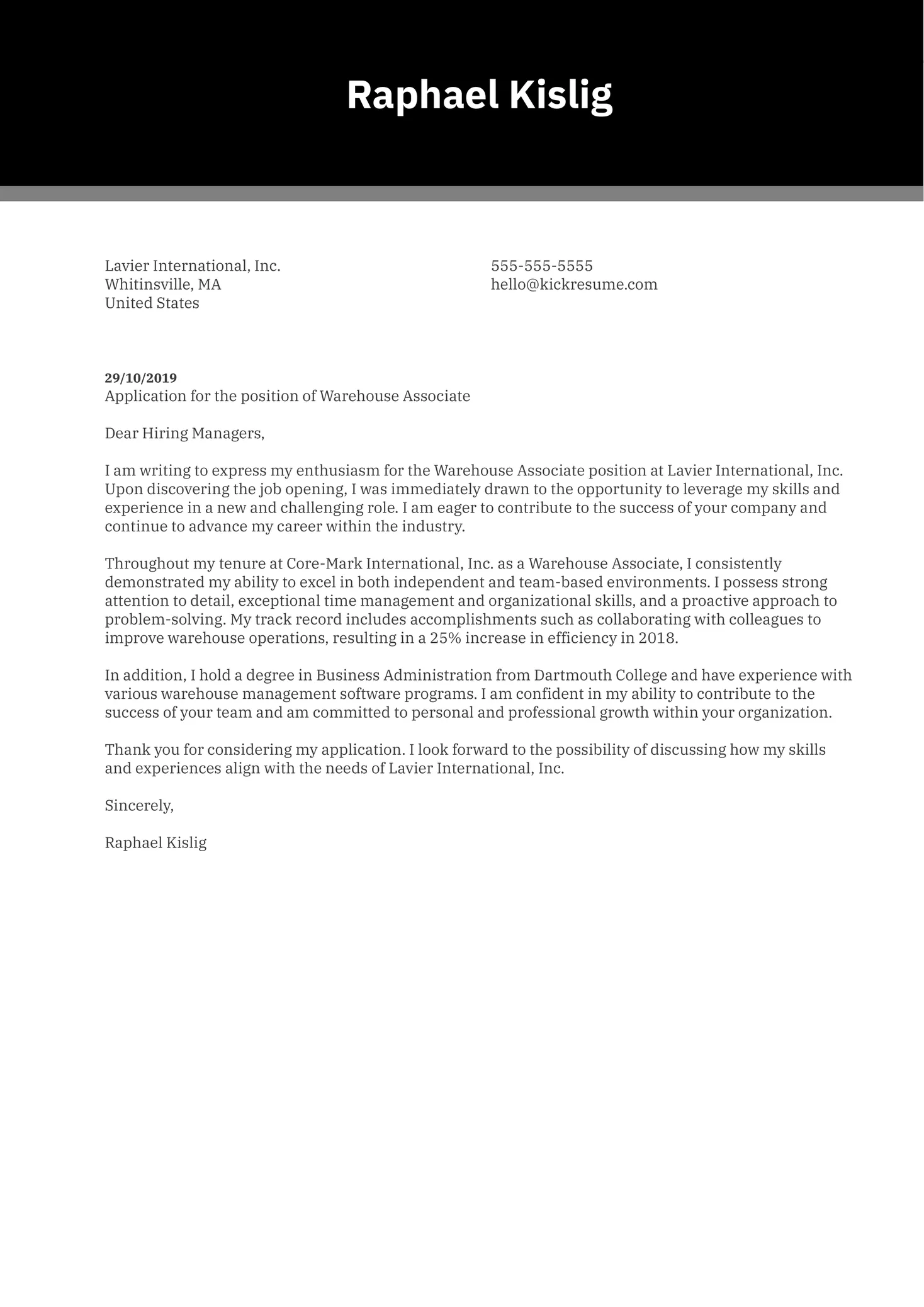
Proofreading is the final step in ensuring your cover letter is polished and professional. Carefully review your letter for any errors in grammar, spelling, and punctuation. Read your letter aloud to catch any awkward phrasing or unclear sentences. It’s also helpful to have someone else proofread your letter, as a fresh pair of eyes can often catch errors that you might miss. Always use a spell checker, but don’t rely on it completely. A well-proofread cover letter demonstrates attention to detail and professionalism, and it significantly increases your chances of making a positive impression.
Additional Tips for Success
Beyond the basics, several additional tips can increase your chances of success. Research the company you’re applying to, follow up on your application, and tailor your letter to the specific job description. Highlighting your achievements, using action verbs, and quantifying your accomplishments are all effective strategies. Make sure your resume and cover letter are aligned, and that they tell a consistent story about your skills and experience. Always be professional and enthusiastic in your communication, and let your personality shine through. Following these tips will help you write a compelling cover letter that stands out from the competition.
Researching the Company
Before you start writing your cover letter, research the company you’re applying to. Visit their website, read about their mission and values, and understand their products or services. This will help you tailor your cover letter to their specific needs and demonstrate your genuine interest. Mentioning something specific about the company in your letter shows that you’ve taken the time to learn about them. Knowing about the company’s culture will also help you determine if you’re a good fit. Showing a genuine interest in the company will greatly enhance your application.
Following Up After Submission
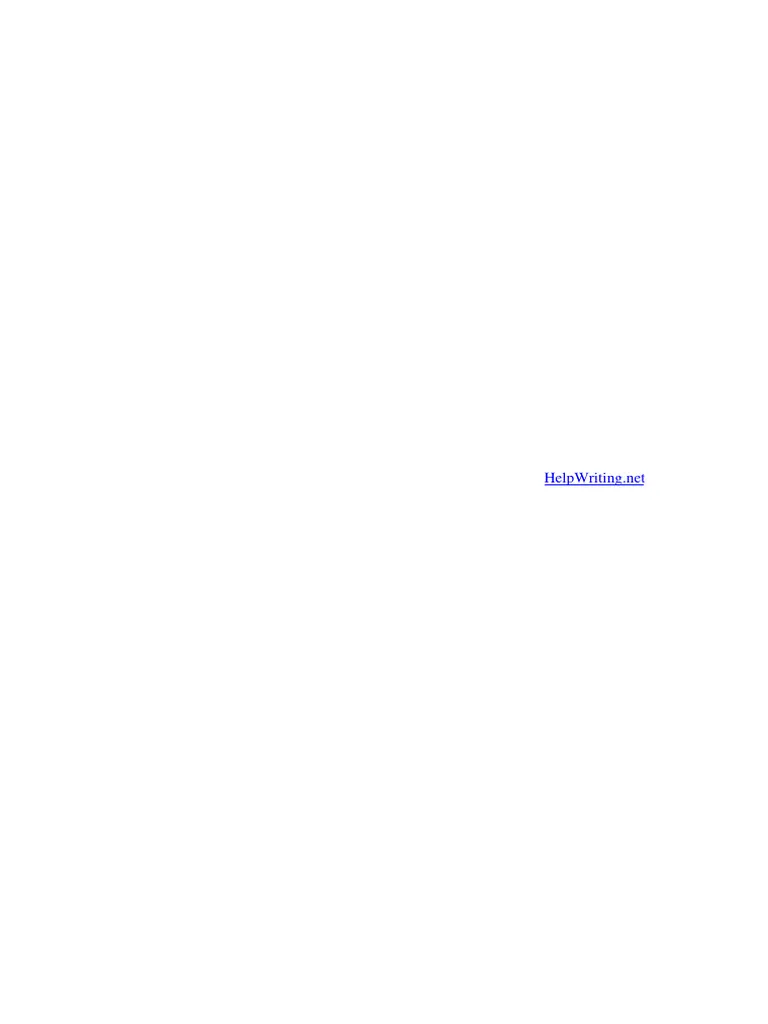
After submitting your cover letter and resume, it’s important to follow up. Send a polite email or make a phone call a week or two after applying to inquire about the status of your application. This demonstrates your continued interest in the position and shows that you are proactive. If you have the hiring manager’s name, address your follow-up directly to them. Keep your follow-up brief, polite, and professional. This is another opportunity to reiterate your interest and remind the employer of your qualifications.
